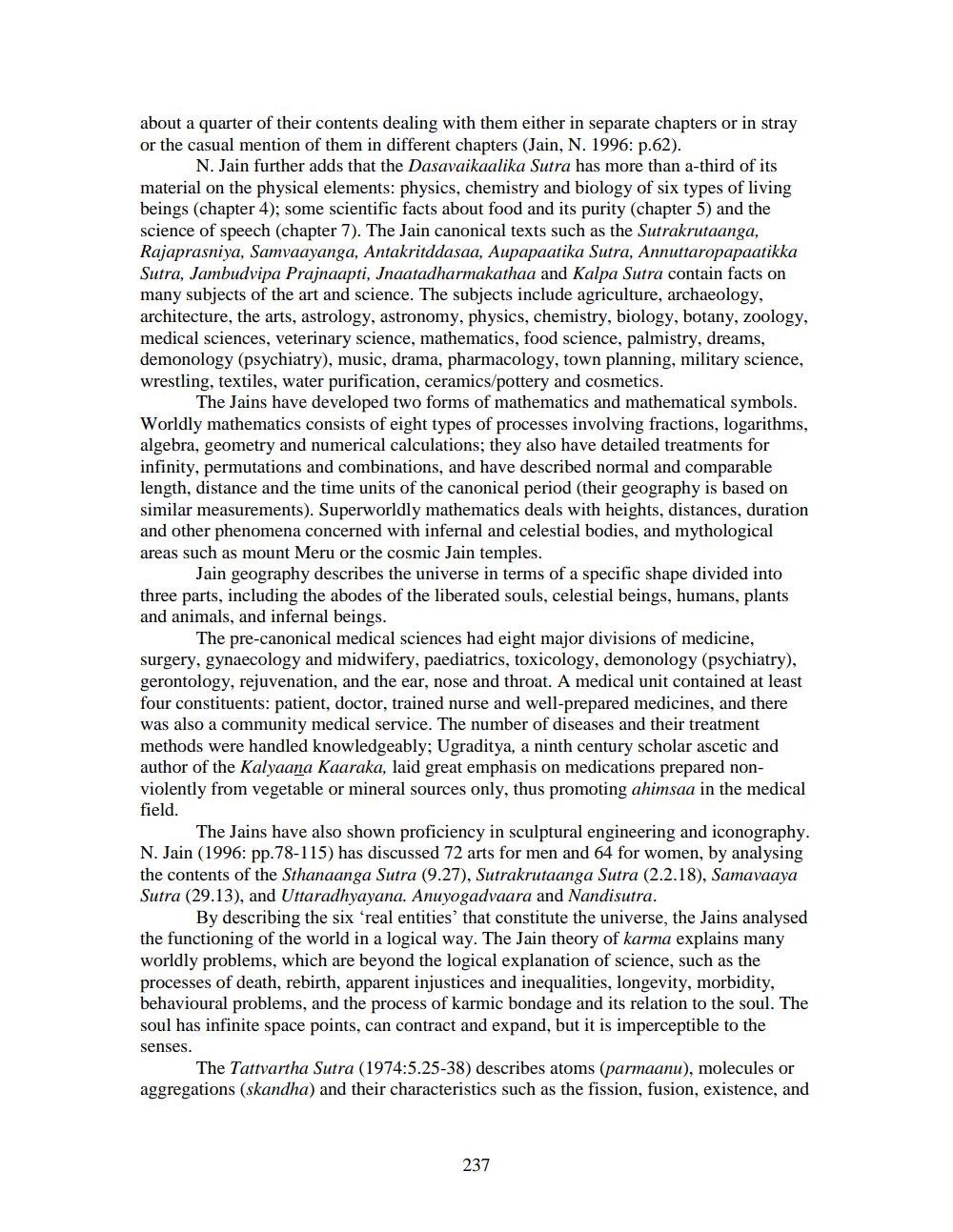________________
about a quarter of their contents dealing with them either in separate chapters or in stray or the casual mention of them in different chapters (Jain, N. 1996: p.62).
N. Jain further adds that the Dasavaikaalika Sutra has more than a-third of its material on the physical elements: physics, chemistry and biology of six types of living beings (chapter 4); some scientific facts about food and its purity (chapter 5) and the science of speech (chapter 7). The Jain canonical texts such as the Sutrakrutaanga, Rajaprasniya, Samvaayanga, Antakritddasaa, Aupapaatika Sutra, Annuttaropapaatikka Sutra, Jambudvipa Prajnaapti, Jnaatadharmakathaa and Kalpa Sutra contain facts on many subjects of the art and science. The subjects include agriculture, archaeology. architecture, the arts, astrology, astronomy, physics, chemistry, biology, botany, zoology, medical sciences, veterinary science, mathematics, food science, palmistry, dreams, demonology (psychiatry), music, drama, pharmacology, town planning, military science, wrestling, textiles, water purification, ceramics/pottery and cosmetics.
The Jains have developed two forms of mathematics and mathematical symbols. Worldly mathematics consists of eight types of processes involving fractions, logarithms, algebra, geometry and numerical calculations; they also have detailed treatments for infinity, permutations and combinations, and have described normal and comparable length, distance and the time units of the canonical period (their geography is based on similar measurements). Superworldly mathematics deals with heights, distances, duration and other phenomena concerned with infernal and celestial bodies, and mythological areas such as mount Meru or the cosmic Jain temples.
Jain geography describes the universe in terms of a specific shape divided into three parts, including the abodes of the liberated souls, celestial beings, humans, plants and animals, and infernal beings.
The pre-canonical medical sciences had eight major divisions of medicine, surgery, gynaecology and midwifery, paediatrics, toxicology, demonology (psychiatry), gerontology, rejuvenation, and the ear, nose and throat. A medical unit contained at least four constituents: patient, doctor, trained nurse and well-prepared medicines, and there was also a community medical service. The number of diseases and their treatment methods were handled knowledgeably; Ugraditya, a ninth century scholar ascetic and author of the Kalyaana Kaaraka, laid great emphasis on medications prepared nonviolently from vegetable or mineral sources only, thus promoting ahimsaa in the medical field.
The Jains have also shown proficiency in sculptural engineering and iconography. N. Jain (1996: pp.78-115) has discussed 72 arts for men and 64 for women, by analysing the contents of the Sthanaanga Sutra (9.27), Sutrakrutaanga Sutra (2.2.18), Samavaaya Sutra (29.13), and Uttaradhyayana. Anuyogadvaara and Nandisutra.
By describing the six 'real entities' that constitute the universe, the Jains analysed the functioning of the world in a logical way. The Jain theory of karma explains many worldly problems, which are beyond the logical explanation of science, such as the processes of death, rebirth, apparent injustices and inequalities, longevity, morbidity. behavioural problems, and the process of karmic bondage and its relation to the soul. The soul has infinite space points, can contract and expand, but it is imperceptible to the
senses.
The Tattvartha Sutra (1974:5.25-38) describes atoms (parmaanu), molecules or aggregations (skandha) and their characteristics such as the fission, fusion, existence, and
237




